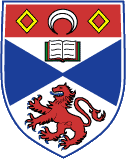Team:St Andrews
From 2010.igem.org
| Home | Team | Official Team Profile | Project | Parts Submitted to the Registry | Modeling | Notebook | Safety |
|---|
The St Andrews iGEM team plan is to do something useful with quorum sensing – the method by which bacteria make decisions in a cell density dependent manner. They do this by secreting autoinducer molecules, which diffuse back into the cells and upregulate their own biosynthesis. This results in a threshold switching behaviour which is used to activate or deactivate certain genes at high cell density. Our idea is that engineered bacteria could secrete the specific autoinducer of another species, resulting in switching at much lower cell density than normal. Our target is Vibrio Cholerae, the aquatic bacterium responsible for the diarrhoeal disease, cholera. Cholera is extremely rare in the developed world, but in areas with poor sanitation it infects people who drink unsafe water. Young children are the most at risk, and left untreated death can occur by dehydration. A useful cholera vaccine which is suitable for children has not yet been found. A probiotic bacterium that colonises the gut could confer long lasting resistance, safely and economically. Most cholera cells are killed off by stomach acid, but those that remain alive attach to the gut wall and multiply. At this low cell density, autoinducer concentration is low, and virulence factors are expressed. Once high cell density is reached, enough toxin is present to cause the characteristic severe diarrhoea. At this point, the autoinducer concentration is high, and virulence factors are repressed. The now avirulent bacteria detach from the gut wall and are flushed out of the body to infect a new host. Our engineered E. coli will harmlessly colonise the gut, and in large numbers secrete the cholera autoinducer, CAI-1. This will cause an immediate high autoinducer concentration to be detected by incoming V. cholerae cells which become avirulent and harmlessly pass out of the body. The wet work will focus on two challenges. The first being to add new functionality to the cell signalling parts present in the library by building a bi-stable switch by re-engineering the existing LuxR quorum sensing system. This will allow the signalling molecule concentration required to activate the system to be different to the concentration required to deactivate it. We will characterise this system by using a fluorescent protein reporter and measuring fluorescence at different cell densities. The second challenge will be adding the cholera autoinducer synthase gene CqsA to E. coli so that CAI-1 is secreted. The eventual aim is that the bistable switching system will be used to control CqsA expression, so that the ability to compete with other bacteria in the human gut is not compromised by this metabolic burden. The computational side of the team are focusing on generating ordinary differential equations to model quorum sensing. and will aim towards modelling more complex problems such as bistability and multiple quorum loops working in tandem. | File:St Andrews team.png Your team picture |
 "
"
